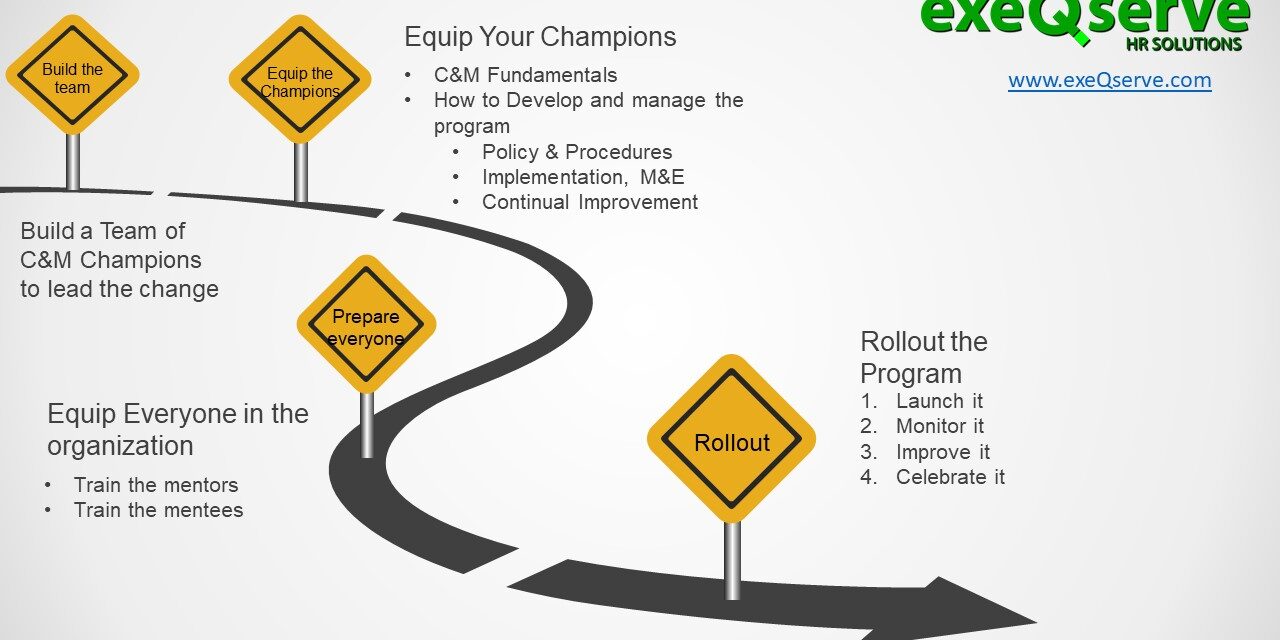First of all, let me sell you the big idea of building and strengthening your company’s mentoring culture. A well-implemented mentoring program can do a lot of good for the company. It is the most effective and efficient way of developing talents. It improves the communication, listening, facilitating, and learning skills of the company’s managers and designated mentors. With employees improving their competencies, and leaders becoming better leaders, think about how much impact that can make for your organization.
Given the potential benefits of mentoring in an organization, no wonder why companies are training their supervisors and managers to become mentors. If your company is not… WHY???
There are dozens of courses out there on mentoring, well, and coaching. It is a lucrative business, and I can only imagine how much in total companies are spending on training. With all this money and effort invested in developing coaching and mentoring competencies, why are many organizations failing to build the necessary culture? I have a few observations to share and some recommendations.
What Does a Good Mentoring Program Look Like?
The International Standards for Mentoring and Coaching Programmes (ISMCP) say that a good program has three features; it is thoughtfully designed, systematically managed, and significantly contributing to the development of the participants, strategic drivers of the organization, and wider stakeholder objectives. It is that the last criterion is dependent on the first two. A good Mentoring program is well-designed and managed. Given these requirements, many companies focus mostly on training supervisors on coaching conversations, and often focusing even more narrowly on constructive feedback and corrective conversations. After the training, the learners go back to their natural habitat with no responsibility to apply what they learned in the workplace. What a waste of time, money, and effort! We need to do better than this if we are to get the maximum benefit in Building a Mentoring Culture!
Build Your Company’s Mentoring Culture
Building a mentoring culture is an important talent development strategy. If you are using a Balanced Score Card in your organization, this goes into your learning growth initiative. You need to have a strategy to make it work. If your only strategy is to send people to training, that is not a strategy, it’s a knee-jerk reaction. Here are a few first steps to consider:
- Lead the Change – Kotter’s change model starts with creating the urgency for change. If you are the mentoring advocate in your organization, you will need to get people’s buy-in on adopting a mentoring culture. Sell mentoring to your stakeholders. Start with the organization’s leaders. Prepare a well-researched presentation on the benefits and costs of building a mentoring culture in your organization. You need to win the leaders because they will help you take care of Kotter’s steps 2 and 3; Build a guiding coalition, and create a vision and initiatives for change.
- Equip your change leaders – Part of building a guiding coalition should be making sure that they know how to champion mentoring as a change initiative. If they had no formal training on the fundamentals of mentoring and coaching, don’t have an understanding of what it takes to create a mentoring program, they may struggle to create the vision or develop the strategy for implementing it. If they are not open to the idea of being coached or mentored, they will not be able to model the way. My recommendation is just before your guiding coalition develops the vision and strategy for building a mentoring culture in your organization, give them the necessary training.
- Develop the program before sending people to training – A good program is thoughtfully designed, and systematically managed. You will need a set of policies, procedures, rewards, and recognition mechanisms to incentivize alignment. Some things to consider in your policy are as follows but not limited to:
- Mentoring program goals and objectives
- How to identify mentors (by appointment or by enrollment?)
- How to get a mentor
- Mentoring ground rules
- Mentoring process and procedures
- Recognition program
- Continual improvement
- Continual capacity development
- Prepare the mentors and the mentees – One of the biggest mistakes I think that organizations make is that they train managers and supervisors to be mentors and coaches but, do not effectively equip employees to proactively seek out mentoring and coaching. When managers initiate mentoring or coaching conversation, it is often to address a concern or a performance issue. Often the objective is corrective rather than proactive capacity development. That is such limited use of the program. My recommendation is to orient them on the full spectrum of what mentoring can do outside of correcting mistakes, and train employees so that they will actively seek and engage in a mentoring relationship.
- Launch your mentoring program in a big way – Kotter’s Steps 4 to 8 focus on making the change happen and integrating it into the organization’s culture. It needs a good start. I can’t think of anything better than creating an event where the organization leader announces the formal start of the mentoring program, acknowledging the first set of mentors and mentees, and talk about how anyone can get into the action.
- Keep track of progress and need for continual improvement – very few efforts if there is any that came out perfect on the first try. The Mentoring champions should take it upon themselves (and make it a part of the program) to monitor the progress of the mentoring engagement, calculate ROIs, identify learning and improvement opportunities, and tweak the system as needed.
I do have a hidden agenda. If you came this far in reading this article, I hope I got you interested enough to consider learning more about how you can make mentoring work in your organization. If you do, check the following link ExeQserve’s Coaching and Mentoring Series to find out how we can help you build your company’s mentoring culture. You may also call us to discuss a customized intervention for the organization. Believe me, It’s worth it.













